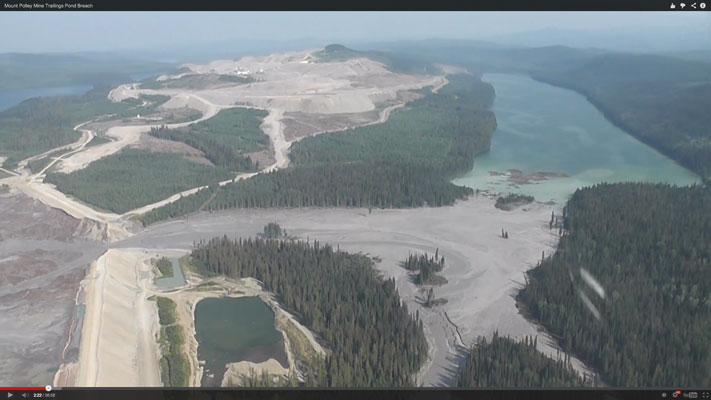
Tailings breach: Water ban partially lifted as testing continues
by The Canadian Press

Early tests show water quality after the tailings pond leak is within parameters for human consumption but exceed long-term exposure limits for wildlife
LIKELY, B.C.—The water ban has been lifted for residents of a remote British Columbia community about a week after a tailings dam failed and released mine waste into a nearby lake.
As many as 300 people were affected by the water ban, which took effect on August 4 when 10 million cubic metres of water and 4.5 million cubic metres of silt were released from the tailings pond at Imperial Metals’ Mount Polley gold and copper mine, about 600 kilometres northeast of Vancouver.
Dr. Trevor Corneil of Interior Health said the town of Likely, B.C., which is the closest town to the mine, and areas north on the Quesnel River can use their water as they normally would. However, the ban remained in effect for residents and tourists along southern parts of the river and Quesnel Lake, along with Polley Lake and Hazeltine Creek, which are adjacent to the mine.
The water ban was partially rescinded as the provincial Environment Ministry released a second round of test results that showed water in the area was within guidelines for human consumption.
“We do feel comfortable in the context of risk for human health rescinding the order (in those areas),” said Corneil. “It meets the Canadian drinking water standards, as well as standards for potable drinking water in multiple systems.”
Read More:
The Cariboo Regional District said 100 to 200 residents were still under a ban, though the precise number is difficult to count because so many tourists come and go from the area.
The second round of results were based on samples taken on August 5 at various spots along Quesnel River.
“Analysis of these samples indicate that none of the chemical and physical parameter concentrations exceeded B.C. or Health Canada drinking water guidelines,” said a memo that was distributed with the results.
All five testing sites had zinc levels above chronic, or long-term, exposure limits for aquatic life, which an accompanying memo said could be a problem if it persists.
“Further samples will be collected to identify whether this concentration remains at this level over a longer period, which would indicate a greater potential impact to the most sensitive aquatic life,” the memo said.
One of the reasons health officials are reluctant to lift the water ban entirely is Polley Lake—which flows into a creek that drains into Quesnel Lake—is currently plugged by tailings debris. The lake’s water level is much higher than normal and officials are worried the debris could break apart and send a dangerous wave of untested water down the creek.
Imperial Metals Corp. is building a pipe to manually divert the lake’s water, but Environment Minister Mary Polak said water from Polley Lake wouldn’t be allowed to enter Quesnel Lake until it meets drinking water guidelines.
Imperial Metals is building a temporary berm to prevent water and tailings from leaking out, but it’s not expected to be finished for weeks.
“The construction of the berm to prevent further tailings from flowing into Hazeltine Creek began last night (Thursday) and the company estimates that it will take about three weeks to complete,” said the news release.
The Environment Ministry sent Imperial Metals a pollution abatement order on August 5, and the ministry said the company has so far complied with reporting and planning deadlines.
There have been questions about the stability and maintenance of the tailings pond, though the company insists the dam was properly built and maintained and that there were never any problems with the dam before.
A consultant who authored an environmental report in 2011 said this week that the tailings pond water was too high when he examined it, and a former worker has also come forward to say he warned his superiors that the dam wasn’t safe.
Knight Piesold Ltd., an engineering firm that was previously the engineer of record for the tailings facility, issued a statement August 8 that said when it ended its relationship with the mine, it sent the company a memo that noted “the embankments and the overall tailings impoundment are getting large and it is extremely important that they be monitored, constructed and operated properly to prevent problems in the future.”
Knight Piesold’s statement said that when it was involved with the mine, the tailings pond was “operated safely and as it was designed.”
The provincial government’s written update on August 8 said the company submitted yearly dam inspection reports and that the mine had received 16 geotechnical inspections since 1995. Its most recent inspection last September did not result in any inspection orders.
